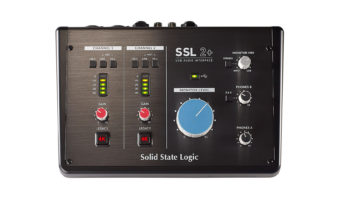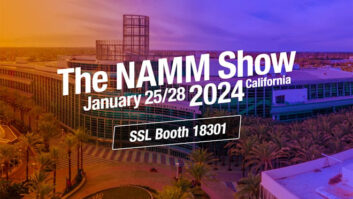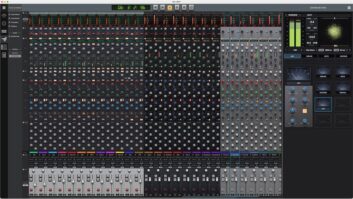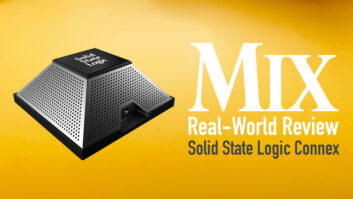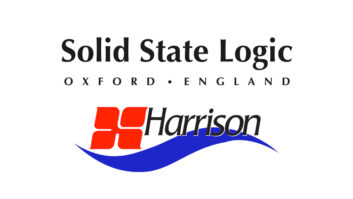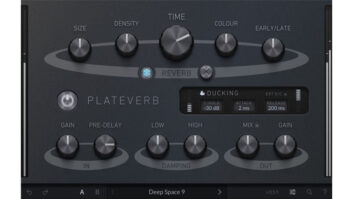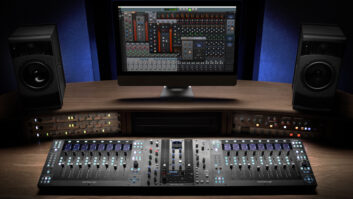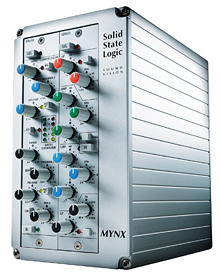
The Mynx accepts two X-Rack modules but doesn’t support Total Recall.
Solid State Logic’s new Mynx puts the manufacturer’s SuperAnalogue processing on fire sale. It’s a tabletop, powered chassis that accommodates up to two X-Rack modules, but without Total Recall capability. For this review, I tested the Mynx with the Channel EQ and VHD Input single-slot modules, and the two-slot Stereo Buss Compressor module installed in turn. Other X-Rack modules that the Mynx can accept include the Mic Pre, Dynamics, Eight Channel Input, Four Channel Input and the Master Buss. The latter provides mixing and monitoring facilities.
VHD Input Module
SSL provides the necessary screws and hex wrenches to install modules quickly and easily. An external power supply connects to the Mynx via a cable terminated with a multipin connector. The Mynx has no on/off power switch, a minor disappointment. While some modules require a D-Sub terminated snake with XLR fans, all of the modules I reviewed use standard balanced XLR connections.
The first module tested offered the VHD (Variable Harmonic Drive™) mic preamp based on the Duality console and a separate switch-selectable line-input signal path. Mic input and line input and output connectors are on the module’s rear panel.
All rotary controls on the module are continuously variable. The rotary VHD control adds second harmonic distortion (similar to what tube circuits produce) to the mic-input signal when set fully counter-clockwise. As the knob is turned clockwise, the distortion increases and becomes progressively dominated by third harmonic distortion, producing the trashy sound of transistors overloading when the knob is at full-clockwise position.
Only the mic-input stage can access the VHD section, but line signals can be accommodated by routing them to the module’s mic-input connector and activating a high-impedance switch. Switches for +48-volt phantom power and a 20dB pad serve the mic section only. A phase switch serves either mic or line input. Other features include defeatable and independent high- and lowpass filters and the highly idiosyncratic “Listen Mic” Compressor originally from SSL’s E Series console.
Channel EQ Module
This module provides four bands of EQ, with continuously variable rotary controls for boost/cut and frequency selection. The top and bottom bands can be switched to provide either high and low shelving filters, respectively, or bell-curve filters with fixed Q. The two middle bands are fully parametric, having rotary Q controls that range continuously in value from about 0.5 to 2.5.
Users can select either SSL’s E Type or G Type equalization for all bands. E Type gives a more exacting response for shelving filters and a constant frequency bandwidth at different gain settings for peaking filters. G Type EQ produces a little resonant undershoot (when boosting) or overshoot (when cutting) at a shelving filter’s corner frequency and a narrowing frequency bandwidth with increasing gain applied to bell-curve filters.
Adjacent bands provide generous overlap in their frequency ranges. Mynx provides 16.5 or 20 dB of boost/cut for each band, depending on the band selected, and all gain controls are detented at unity gain. Although a global bypass switch is provided, the module lacks individual band-bypass switches and a global output gain control.
Stereo Buss Compressor Module
This beauty is based on the bus compressor in the XL 9000 K Series console. Separate left- and right-channel line and key inputs and line outputs are provided along with -10/+4dB switches on the module’s rear panel. Either or both of the key inputs can be used to insert an equalizer, for example, to condition the sidechain for de-essing applications, or to insert the mult of a track to trigger ducking action. (Depressing a Key switch on the front panel sends the conditioning signal to the sidechain.) Alternatively, two or more Stereo Buss Compressor modules may be linked by daisy-chaining line outputs to key inputs and depressing Link switches on the modules’ front panels. Whether using the key or link function, the loudest signal always determines the compressors’ action.
Strangely, the key and link switches are untitled. Joining them on the front panel are five rotary controls: continuously variable threshold and makeup-gain pots and stepped attack, release and ratio controls. Stepped controls have six settings each. Ratios range between 1.5:1 and 10:1, while attack settings go from 0.1 to 30 ms. Manual release values are between 0.1 and 1.6 seconds; alternatively, you can choose an Auto setting for program-dependent release times. Thankfully, a bypass switch is provided, which makes all controls — including makeup gain — inactive.
The Tracks of My Gear
The VHD Input module made everything it touched sound golden. Female lead vocals miked with a Lawson L47MP tube mic sounded stellar with the VHD circuit disabled. Warmth, detail, clarity, depth and perfect spectral balance — it had it all. On amplified electric guitar recorded with a Royer R-122 ribbon mic, the VHD circuit wowed me by adding a rich, velvety texture. And on a Strat recorded via DI (plugged into an upstream Demeter Tube Direct Box), a little VHD processing added sweet sparkle.
Line signals also benefited from VHD processing. Pre-recorded kick, snare and bass tracks took on more size and luster. When processing a drum room mic’s signal with the Listen Mic Compressor, I got an appropriately trashy sound in which ambience was increased, and lows and highs were rolled off.
Having a choice of E and G Type equalization made tweaking various tracks with the Channel EQ module a real treat. I generally preferred the G Type EQ on kick and snare, as it made the kick sound a hair more punchy and made the snare drum pop a tad more than with E Type EQ applied.
The E Type EQ, on the other hand, was my fave on electric bass guitar. The lack of overshoot on low-shelving boost lent an even tone across all notes and sounded absolutely huge. This EQ reaches deep.
My Favorite Squeeze
Simply put, the Stereo Buss Compressor is hands down the best stereo compressor I’ve heard on strummed acoustic guitar. Dialing in a 10:1 ratio, 30ms attack, and 0.8sec release for 8dB gain reduction on peaks, the sound was absolutely stunning — and unlike anything I could achieve using other gear. The instrument sounded huge and very tightly controlled, with no unwieldy blooming of low frequencies.
On banjo (miked at the bridge with a Royer R-122 and on the neck with a condenser mic), a 5:1 ratio and fast release time produced stellar results. The compressor evened out the level of all notes, making the instrument sit much better in the mix. It also mellowed the glassy bite of the condenser mic.
The Stereo Buss Compressor also sounded phenomenal on a drum-kit subgroup. Eight to 15 dB of gain reduction produced spanked, slammin’ drums with a big but tight and extended low end and warm and scintillating highs.
My only complaint with this module is that the name of each control is printed below its knob, making it difficult to see.
Wow!
A fully loaded Mynx isn’t exactly inexpensive, but it puts SuperAnalogue processing within reach of all but the most modest budgets. That processing is the sound heard on hit records — which makes the Mynx a certifiable hit.
Michael Cooper has written more than 300 articles about pro audio over the past 20 years.


